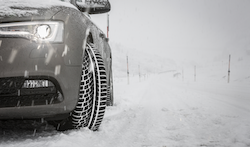The question of whether all-weather tires can be used in winter conditions is very common, as you also have all-season tires, which sound very similar. It is a bit confusing, and the answer is that tires that are approved for winter use can be used during winter conditions. They should then have the severe service emblem on the sidewall of the tires. This isn’t the same as the M+S marking. When it comes to all-season tires, they are not approved for winter use, while the all-weather tires are tires that have been developed for winter use and should therefore have the severe service emblem, also known as the Alpine symbol, as it has a mountaintop with three peaks and a snowflake. So if your all-weather tires have this symbol, then they can be used.
This “three-peak mountain snowflake “ symbol is the same symbol that you will find on winter and snow tires. This marking signifies that they have passed the tests for use in severe winter conditions. Therefore, the all-weather tires are very different versus the all-season tires have a very confusing name, as they are not recommended for winter use. The all-weather tires allow for one set of tires throughout the year, with no need for a change of tires. Thus eliminating the need for storing the second set of tires during the winter season and also not having to have two sets of rims.
By using all-weather tires, you can safely drive in conditions with ice, snow and slush as they provide excellent grip and handling in these conditions. All-weather tires are made with an intermediate rubber compound and a tailored tread that offers excellent grip on all kinds of road conditions. They are a sort of a hybrid between winter tires and all-season tires, making them ideal for both summer and winter seasons. This is why during the traditional winter season, when the roads can be filled with snow and ice, they can perform just as well as when you have dry and wet roads during warmer conditions.
The special tread pattern with grooves effectively cleans snow, slush and water out of the grooves of the tires to ensure constant grip and reliable handling under all conditions and also thereby protecting from hydroplaning. Hydroplaning can also occur when you have water on the road, but also when the snow melts and turns into slush. This can assure hydroplaning resistance both in heavy rain or melting ice and snow. This allows you to maintain proper contact with the road and provide the stability you need to handle your vehicle safely and comfortably.
All-weather tires are the only ones that can be used all year round if severe winters in your area. If the area you live in doesn’t have severe winters, you can use all-season tires throughout the year. The many innovations in all-weather and all-season tires alike make them both equally good to handle the other three seasons of the year. There have also been many advances in the all-weather tires by lowering the rolling resistance of the tires. This makes them more fuel-efficient and helps to make them more ecological.
For more information on all-weather tires, visit https://www.nokiantires.com/
